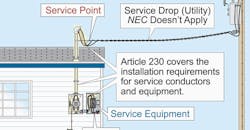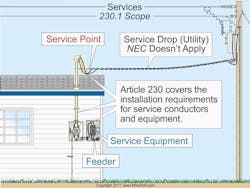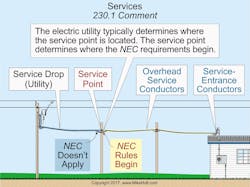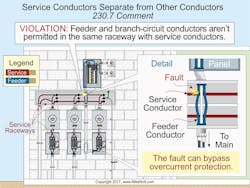In Part 1 of this two-part series, we will address the general requirements for services. In our next installment, we will address the requirements for the disconnecting means and overcurrent protection.
Article 230 covers the installation requirements for service conductors and service equipment (Fig. 1). To know when the requirements of Art. 230 apply, you need to understand three critical definitions.
1. Service point. The point of connection between the serving electric utility and the premises wiring.
2. Service conductors. The conductors from the service point to the service disconnecting means. Service-entrance conductors can either be overhead or underground.
3. Service equipment. The necessary equipment, usually consisting of circuit breakers or switches and fuses and their accessories, connected to the load end of service conductors at a building or other structure, and intended to constitute the main control and cutoff of the electrical supply. Service equipment doesn’t include individual meter socket enclosures [Sec. 230.66].
From these definitions, you can see that service conductors originate at the serving electric utility (service point) and terminate on the line side of the service disconnect. The electric utility typically determines where the service point is located. The service point determines where the NEC requirements begin
(Fig. 2).
Conductors and equipment on the load side of service equipment are considered feeder conductors or branch circuits; you must install those per Art. 215 and Art. 210, respectively. They must also comply with Art. 225 if they’re outside branch circuits and feeders, such as the supply to a building. Feeder conductors include:
• Secondary conductors from customer-owned transformers,
• Conductors from generators, uninterruptible power supply (UPS) systems, or photovoltaic (PV) systems, and
• Conductors to remote buildings.
Article 230 consists of seven parts:
1. Part I. General
2. Part II. Overhead Service Conductors
3. Part III. Underground Service Conductors
4. Part IV. Service-Entrance Conductors
5. Part V. Service Equipment
6. Part VI. Disconnecting Means
7. Part VII. Overcurrent Protection
Figure 230.1 in the NEC provides a good pictorial representation of this arrangement.
Number of Services
Only one service drop or lateral can serve a building, except as permitted by Sec. 230.2(A) through (D).
For the purposes of Sec. 230.40, Exception No. 2, underground sets of conductors, 1/0 AWG and larger, running to the same location and connected at their supply end, but not connected at their load end, are considered to be supplying one service.
(A) Special Conditions. Additional services are permitted for the following:
(1) Fire pumps
(2) Emergency systems
(3) Legally required standby systems
A separate service for emergency and legally required systems is permitted only when approved by the authority having jurisdiction [Sec. 700.12(D) and Sec. 701.12(D)].
(4) Optional standby power
(5) Parallel power production systems
(6) Systems designed for connection to multiple sources of supply to enhance reliability.
To minimize the possibility of simultaneous interruption, the disconnecting means for the fire pump, emergency system, or standby power system must be located away from the normal power disconnecting means [Sec. 230.72(B)].
(B) Special Occupancies. By special permission, additional services are permitted for:
(1) Multiple-occupancy buildings where there’s no available space for supply equipment accessible to all occupants, or
(2) A building or other structure so large that two or more supplies are necessary.
(C) Capacity Requirements. Additional services are permitted:
(1) If the capacity requirements exceed 2,000A, or
(2) If the load requirements of a single-phase installation exceed the electric utility’s power capacity, or
(3) By special permission.
Special permission is defined in Art. 100 as “the written consent of the authority having jurisdiction.”
(D) Different Characteristics. Additional services are permitted for different voltages, frequencies, or phases, or for different uses, such as for different electricity rate schedules.
(E) Identification of Multiple Services. If a building is supplied by more than one service, or a combination of feeders and services, a permanent plaque or directory must be installed at each service and feeder disconnecting means location to denote all other services and feeders supplying that building, and the area served by each.
Outside Conductors
When are conductors considered outside of a building [Sec. 230.6]? When they’re installed:
(1) Under at least 2 in. of concrete beneath a building.
(2) Within a building within a raceway encased in at least 2 in. of concrete or brick.
(3) In a vault that meets the construction requirements of Art. 450, Part III.
(4) In a raceway at least 18 in. below a building.
(5) Within rigid or intermediate metal conduit that passes directly through an eave but not a wall of a building.
Keep Conductors Separate
With two exceptions, feeder and branch-circuit conductors cannot be installed in a service raceway containing service conductors [Sec. 230.7].
Exception No. 1: Grounding electrode conductors or supply-side bonding jumpers are permitted in a service raceway with service conductors.
Exception No. 2: Conductors used for load management with overcurrent protection are permitted in service raceways with service conductors.
Warning: Overcurrent protection for the feeder or branch-circuit conductors can be bypassed or a fault can occur if service conductors are mixed with feeder or branch-circuit conductors in the same raceway and a fault occurs between the service and feeder or branch-circuit conductors (Fig. 3).
This rule doesn’t prohibit the mixing of service, feeder, and branch-circuit conductors in the same service equipment enclosure.
This requirement may be the root of the misconception that “line” and “load” conductors can’t be installed in the same raceway. It’s true that service conductors can’t be to be installed in the same raceway with feeder or branch-circuit conductors, but line and load conductors for feeders and branch circuits can be in the same raceway or enclosure.
Some Miscellaneous Rules
These rules don’t take up much space in Art. 230 or get much explanation. Arguably, they are just common sense. Yet, they need to be said.
• No pass-throughs. Service conductors must not pass through the interior of another building or other structure [Sec. 230.3].
• Seal raceways. Underground raceways (used or unused) entering buildings must be sealed or plugged to prevent moisture from contacting energized live parts [Sec. 230.8, Sec. 225.27, and Sec. 300.5(G)].
• Stay out of trees. Trees or other vegetation can’t be used for the support of overhead service conductor spans or service equipment [Sec. 230.10].
• Know which code applies. Service-drop conductors installed by the electric utility must comply with the National Electrical Safety Code (NESC), not the NEC [Sec. 90.2(B)(5)]. Overhead service conductors that aren’t under the exclusive control of the electric utility must be installed per the NEC.
Clearance from Building Openings
It’s also common sense to keep service conductors away from building openings. But how far away?
• Overhead service conductors must maintain a clearance of 3 ft from windows that open, doors, porches, balconies, ladders, stairs, fire escapes, or similar locations [Sec. 230.9(A)]. Exception: Overhead conductors installed above a window aren’t required to maintain the 3-ft distance.
• Overhead service conductors within 3 ft measured horizontally of platforms, projections, or surfaces that will permit personal contact, must have a vertical clearance of not less than 10 ft above the platforms, projections, or surfaces in accordance with Sec. 230.24(B) [Sec. 230.9(B)].
• Service conductors aren’t permitted to be installed under an opening through which materials might pass, and they’re not permitted to be installed where they’ll obstruct entrance to building openings [Sec. 230.9(C)].
The Inside Outside Decision
Article 230 covers the installation requirements for service conductors and service equipment. The requirements for service conductors differ from those for other conductors.
For one thing, service conductors for one building can’t pass through the interior of another building or structure [Sec. 230.3], and you apply different rules depending on whether a service conductor is inside or outside a building. When are they “outside” as opposed to “inside?” The answer for a given installation may seem obvious, but always consult when Sec. 230.6 making this decision.
If the service location is not yet final, use the result of this decision to review the proposed service location. If the present choice of location means a long run under a building, would a different location allow a much shorter run? A shorter run would reduce the costs of installation, testing, maintenance, and repair. Consult with the electric utility before making any final decision.
These materials are provided to us by Mike Holt Enterprises of Leesburg, Fla. To view additional Code training materials offered by this company, visit www.mikeholt.com.About the Author

Mike Holt
Mike Holt is the owner of Mike Holt Enterprises (www.MikeHolt.com), one of the largest electrical publishers in the United States. He earned a master's degree in the Business Administration Program (MBA) from the University of Miami. He earned his reputation as a National Electrical Code (NEC) expert by working his way up through the electrical trade. Formally a construction editor for two different trade publications, Mike started his career as an apprentice electrician and eventually became a master electrician, an electrical inspector, a contractor, and an educator. Mike has taught more than 1,000 classes on 30 different electrical-related subjects — ranging from alarm installations to exam preparation and voltage drop calculations. He continues to produce seminars, videos, books, and online training for the trade as well as contribute monthly Code content to EC&M magazine.




